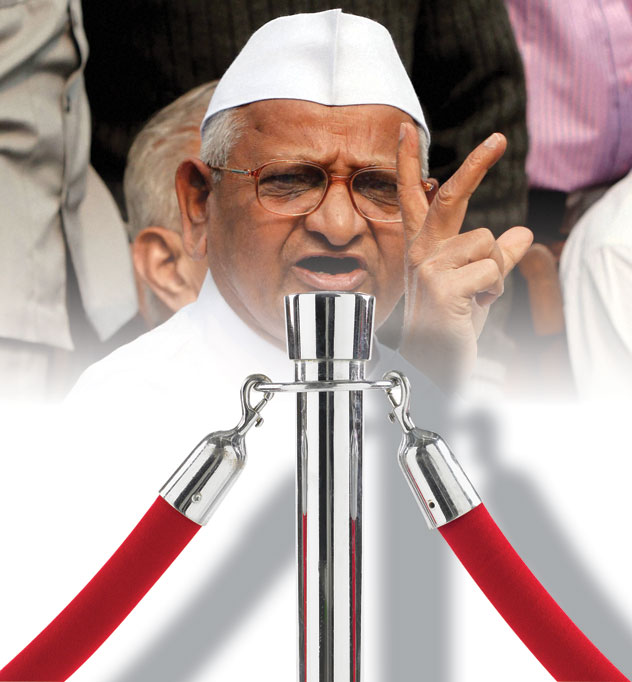OPINION
Four Reasons: Why Time Magazine Dissed Anna Hazare
Time magazine’s year-end issue features ‘The Protestor’ as its ‘Person of the Year.’ While mentioning protests from all over the world, the editors at Time chose to downplay Anna Hazare’s massive movement against corruption in India. Whether this was deliberate, or simply didn’t matter, Sandip Roy and Lakshmi Chaudhry present a commentary.

(Above): The Time Magazine Cover shown above is copyrighted to Peter Hapak | Time
It’s official: 2011 is the Year of the Protester. Time magazine sealed the deal by picking ‘The Protester’ as its ‘Person of the Year.’ The choice was a no-brainer in a year when everyone and their mother picked up a banner and took to the streets, though for varying reasons and to varying effect.
There’s nothing magazine editors like more for their year-end issue than a tidy, catch-all theme that can be stretched to include pretty much everything that mattered. Everyone is present and accounted for in the Time package: Egyptians, Tunisians, Spaniards, Greeks, Americans, the Brits, and… Wait a minute, where are the Indians? Oh, here we are. One throwaway line in the cover story about “Mexico and India and Chile, where citizens mobilized against crime and corruption.”
There is not, however, one Hazare supporter in the 10 individual profiles of protesters, which are chock-a-block with Greeks and Spaniards. Nor do we merit a mention in the editor Rick Stengel’s introduction.
But look, there’s an image of Annaji in Peter Hapak’s photo essay. The relief is short-lived; we notice that Loukanikos — the stray dog that joined the Greek protests – has his very own 11-photo slideshow.
If it’s any consolation, the Brits are just as miffed that Kate Middleton – who at least came in at number 5 – “was snubbed by Time for ‘Person of the Year’ in spite of her fairy tale wedding, keen fashion sense and charitable good deeds.”
Really, people, what is going on! Protesters can keep protesting next year but Kate isn’t going to get married again in 2012!
We aren’t sure about the lovely Kate, but it’s clear that the Hazare movement didn’t quite meet the hallowed standards for protests set by wise Time magazine editors. The criteria for inclusion are perfectly clear and just as revealing:
One, you gotta be young. College kids are great, as are young hip urban professionals and the 20-something unemployed. A super-geeky 29-year old Muslim Brotherhood member carrying a Tigger notebook is especially cool. Protest is always about kids rebelling against their parents – just like those baby boomer, middle-aged Time editors did back in their glory days. Any movement that doesn’t feed into Sixties’ nostalgia isn’t worth a damn.
No one cares about those innumerable boring, over-40 types in Tahrir Square, Madrid, Athens or Moscow. In this carefully edited narrative, old folks have only one role: to dutifully cheer the next generation from the sidelines. A 69-year-old Canadian gets a nod for getting the Occupy movement rolling in the U.S. but luckily with a 29-year-old African American for company.

(Above): Anna Hazare, the leader of India’s protest against corruption.
With a 74-year old man as the face of our anti-corruption protest, we didn’t stand a chance. A doughty, septuagenarian Gandhian was just a little too old-school for the hip storyline that wanted a thousands protests to bloom but not any one leader — especially of the geriatric kind.
Two, only the “non-poor” count. Never mind that the Tunisian revolt was sparked by the self-immolation of a fruit vendor. Or that the Arab middle class never had the numbers to topple the government. There can be no revolution without designers, filmmakers, web entrepreneurs, and dentists – all out on the streets for the first time. The rest are just the usual whiners who don’t count as, for example, in Moscow:
These Russian protesters are a new breed, not just nostalgic old communist grandmas or bullyboy nationalists but yuppies, students, the best and brightest. “So this is what they look like,” said Oleg Orlov, the 58-year-old head of Russia’s main human-rights organization, as he scanned the square at Chistye Prudy the night of Dec. 5. “I’ve never seen them at rallies before, at least not in such enormous numbers. It’s incredible.”
All hail the incredible yuppie, including ageing human rights activists who have spent decades risking their lives.
The protests in India did meet this editorial criterion – it got the middle class out on the streets. But where our Western peers can protest to little visible effect — and still be counted — the rest of us “non-poor” types have to at least overthrow a government to qualify.
Three, it’s always about us, as in U.S. Every protest must have at the most three degrees of separation from the United States. In their desperate attempt to paint everything with the same brushstroke, the editors have clubbed together the Occupy Wall Street protester, the angry Greek, the Egyptian getting killed in Tahrir Square. Yes, the note admits, the risks are different in different places. But Time quickly finds a grand unifying note: “It’s remarkable how much the protest vanguards share. Everywhere they are disproportionately young, middle class and educated.”
Not sure that the dead street vendor in Tunisia quite fits the bill. Or the thousands of produce sellers who led the first wave of protests.
But that’s just nit-picking. We all know that the protests were about “the failure of hell-bent megascaled crony hypercapitalism” and not “enough money tricking down to keep them happyish,” claims the magazine. Sorry, we thought the Arab Spring was about entrenched brutal dictators – or is that one of the many inconvenient facts that don’t fit Time’s United Colors of Protesters template?
We (Americans) are the world. The message is dinned in over and again in carefully selected quotes. Here’s an Egyptian dentist, Ahmed Harara, who lost his eyesight in Tahrir Square to rubber bullets, talking about the most memorable day in 2011: “Actually,” he said, “there are two days — the 28th of January here in Egypt and the day when Americans occupied Wall Street.”
Then there’s the Athens is Alabama moment: “Among the chants in the birthplace of democracy last spring were ‘Yes we can!’ And Anastasopoulos has kept a banner reading ‘Let freedom ring’ — that is, a quote from Martin Luther King Jr. quoting ‘My Country ‘Tis of Thee’.”
In Time’s map of the world, all roads lead right back to the United States. Alas, if only Anna had claimed to be the second coming of Martin Luther King Jr, he’d have at least made it to the top 10.
Four, it’s the Internet, stupid. All protests that “matter” must offer a grand vindication of social media and confirm the stereotype of the plugged-in protester. What connects the Arab Spring to angry Greeks to Occupy Wall Street? Why Facebook, of course:
Two years ago, scholars Nicholas Christakis (Harvard) and James Fowler (University of California, San Diego) published Connected, a groundbreaking study of social networks, which they summarize as “how your friends’ friends’ friends affect everything you feel, think and do.” The protests of the past 12 months look like a spectacular worldwide confirmation of those findings.
It all makes perfect sense – except the real game changer in the Middle East was television. Worse, the usually reviled Al Jazeera. As one Arab protestor said “Al-Jazeera and the Internet were the differences, especially Al-Jazeera – everybody watches TV.”
But Time prefers the revolution-by-social media hypothesis because it offers a hidden bonus. So what if the Arabs didn’t need USA to import democracy? In the end, the invisible hand that made it all happen was still American: “So America’s great 21st century contribution to fomenting freedom abroad was not imposing it militarily but enabling it technologically, as an epiphenomenon of globalization.”
Last year, Time anointed Mark Zuckerberg its ‘Person of the Year.’ This year they get to claim his was the Facebook that launched a thousand protests.
Sure, Team Anna used Facebook as well. But, sadly, much of their early organizing relied on missed calls and SMSing. As the Time mantra states: If you tweet it, they will come. So enough with the texting, already. Note to Time editors: Anna blogs, he really does. Doesn’t that count for something?
The above article was published on Firstpost.com and is sourced from New America Media (newamericamedia.org)
|